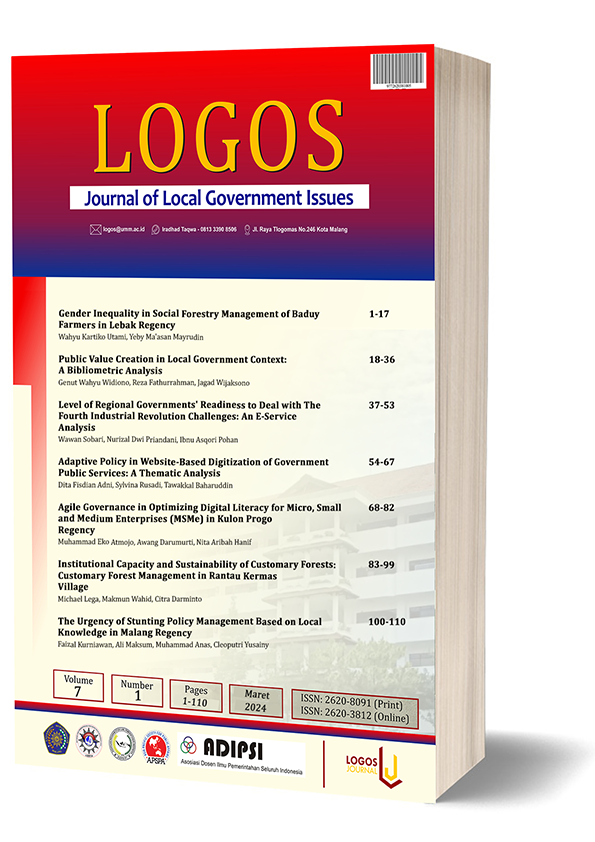Level of Regional Governments' Readiness to Deal with The Fourth Industrial Revolution Challenges: An E-Service Analysis
DOI:
https://doi.org/10.22219/logos.v7i1.25857Keywords:
industrial revolution 4.0, e-service, regional government readinessAbstract
The fourth industrial revolution (industry 4.0) has prompted major changes and challenges in all sectors, including governments. A recent theory explains that one of the challenges is changing needs for public services, requiring appropriate responses from the governments, both at national and regional levels. Departing from this situation, this study seeks to explore the readiness of regional governments to respond to the challenges. Through e-service assessment over applications developed by the Government of Malang Municipality, Malang Regency, and Batu Municipality (Greater Malang), document analysis, and focused group discussion, this study reveals several drawbacks of e-services, namely personnel’s readiness, users’ preparedness, flexibility, integration among applications, lack of socialization, weak support and commitment from leaders, low budget, and infrastructure constraints. These findings confirm previous studies on barriers to e-service delivery. This study also strengthens previous researches on the readiness of governments to meet the challenges of the revolution regarding the importance of administrative innovation initiatives and the role and commitment of leaders. Grounded on the logic beyond the implementation of e-services, this study offers an academic framework concerning the categories of regional governments’ preparedness to deal with the revolution’s challenges, namely the level of readiness for initiation, development, and sustainability.
Downloads
References
Accenture, A. A. (2001). Governments Closing Gap Between Political Rhetoric and eGovernment Realization. Regulation. https://newsroom.accenture.com/news/2001/governments-slowly-begin-closing-gap-between-rhetoric-and-reality-as-they-push-to-create-egovernment-according-to-second-annual-global-accenture-study
Alkhazaleh, R., Mykoniatis, K., & Alahmer, A. (2022). The success of technology transfer in the industry 4.0 era: A systematic literature review. Journal of Open Innovation: Technology, Market, and Complexity, 8(4), 202. https://doi.org/10.3390/joitmc8040202
Andersen, K. ., Henriksen, H. ., Secher, C., & Medaglia, R. (2007). Costs of e-participation: the management challenges, Transforming Government: People, Process, and Policy. 1(1), 29–43.
Asgarkhani, M. (2002). e-Governance in Asia Pacific. Proceedings of the International Conference on Governance in Asia.
Asgarkhani, M. (2004). Digital government: From vision to the reality of strategy implementation. Proceedings of the International Conference on E-Governance, Sri Lanka, 36–46.
Axelsson, K., Melin, U., & Lindgren, I. (2009). Developing public e-services for several stakeholders-A multifaceted view of the needs for an e-service.
Balkaran, S. (2016). The Fourth Industrial Revolution - Its impact on the South African public sector. In Academia (Issue 047).
Chung, C.-S. (2017). ICT Governance Restructure Plan in the era of 4th Industrial Revolution. Journal of Platform Technology, 5(1), 33–40.
Chung, C. S. (2017). E-government future in the era of 4 industrial revolution. Information (Japan), 20(5B), 3539–3548.
Dien Novita. (2014). Faktor-Faktor Penghambat Pengembangan E-Government: Studi Kasus Pemerintah Kota Palembang, Sumatera Selatan. Eksplora Informatika, 4(1), 43–52. https://eksplora.stikom-bali.ac.id/index.php/eksplora/article/view/94
Dikhanbayeva, D., Tokbergenova, A., Lukhmanov, Y., Shehab, E., & Pastuszak, Z., Turkyilmaz, A. (2021). Critical factors of industry 4.0 implementation in an emerging country: Empirical study. Future Internet, 13(6), 137. https://doi.org/10.3390/fi13060137
Heeks, R. (2003). Causes of E-Government Success and Failure: Design-Reality Gap Model. IDPM, University of Manchester.
Hoyer, C., Gunawan, I., & Reaiche, C. H. (2020). The implementation of industry 4.0–a systematic literature review of the key factors. Systems Research and Behavioral Science, 37(4), 557–578. http://dx.doi.org/10.1002/sres.2701
IMD World Digital. (2020). IMD World Digital Competitiveness Ranking 2020. In IMD World Competitiveness Center. https://imd.cld.bz/IMD-World-Digital-Competitiveness-Ranking-2020/18/
Junaidi. (2011). Best Practices Pengembangan E-Government Pada Pemerintah Daerah. Jurnal Administrasi Negara (JAN), II,(1), 24–26.
Kadarisman, M., Wijayanto, A. W., & Sakti, A. D. (2022). Government agencies’ readiness evaluation towards industry 4.0 and society 5.0 in Indonesia. Social Sciences, 11(8), 331. https://doi.org/10.3390/socsci11080331
Karabegović, I., Bičo Ćar, M., Stupar, S., & Šestić, M. (2023). Industry 4.0 Readiness Assessment: Human Resource Readiness and Active Role of Government Administration for Transitional Context of Bosnia and Herzegovina. In International Conference "New Technologies Development and Applications." Springer Nature Switzerland, 389–395.
Kiss, E., Varga, G., & Kuttor, D. (2023). Triple helix in the age of the fourth industrial revolution and the spatial pattern of Hungarian industry. Erdkunde, 77(1), 53–69. https://www.jstor.org/stable/27207755
Li, C., Qiu, Z., & Fu, T. (2021). The Role of Policy Perceptions and Entrepreneurs’ Preferences in Firms’ Response to Industry 4.0: The Case of Chinese Firms. Sustainability, 13(20), 11352. https://doi.org/10.3390/su132011352
Li, M., Cao, G., Li, H., Hao, Z., & Zhang, L. (2023). How government subsidies affect technology innovation in the context of Industry 4.0: evidence from Chinese new-energy enterprises. Kybernetes. https://doi.org/10.1108/K-08-2022-1098
M. Mabkhot, M., Ferreira, P., Maffei, A., Podržaj, P., Mądziel, M., Antonelli, D., & Lohse, N. (2021). Mapping industry 4.0 enabling technologies into united nations sustainability development goals. Sustainability, 13(5), 2560. https://doi.org/10.3390/su13052560
Melin, U., & Axelsson, K. (2009). Managing e-service development-comparing two e-government case studies. Transforming Government: People, Process and Policy. 3(3), 248.
Molla, T., & Cuthbert, D. (2019). Calibrating the PhD for Industry 4.0: Global concerns, national agendas and Australian institutional responses. Policy Reviews in Higher Education, 3(2), 167–188. https://eric.ed.gov/?id=EJ1223527
Mourtzis, D., Angelopoulos, J., & Panopoulos, N. (2022). A Literature Review of the Challenges and Opportunities of the Transition from Industry 4.0 to Society 5.0. Energies, 15(17), 6276. https://doi.org/10.3390/en15176276
Musfikar, R. (2018). Kendala Dalam Implementasi E-Government Pada Pemerintah Kabupaten Pidie. Cyberspace: Jurnal Pendidikan Teknologi Informasi, 2(1), 48. https://doi.org/10.22373/cs.v2i1.2746
Napitupulu, D. (2016). Kajian Faktor Sukses Sistem Layanan Berbasis Elektronik (e-Service) di Lembaga Pemerintahan. Forum Tahunan Pengembangan Iptek Dan Inovasi Nasional VI.
Nath, V. (2003). Digital governance models: moving towards good governance in developing countries. The Innovation Journal: The Public Sector Innovation Journal, 8(1), 1–15.
Ostasius, E, & Petraviciute, Z. (2010). Applying e-service model in assessment and comparison of services. In Working Conference on Virtual Enterprises, 443–450.
Ostasius, Egidijus, & Petraviciute, Z. (2010). Applying e-service model in assessment and comparison of services. IFIP Advances in Information and Communication Technology, 336 AICT, 443–450. https://doi.org/10.1007/978-3-642-15961-9_53
Pabbajah, M., Abdullah, I., Widyanti, R. N., Jubba, H., & Alim, N. (2020). Student demoralization in education: The industrialization of university curriculum in 4.0. Era Indonesia. Cogent Education, 7(1), 779–506. http://dx.doi.org/10.1080/2331186X.2020.1779506
Pole, R. V. (2013). The Effectiveness of E-service in Regional Governance: A Case Study of SARITA. Proceedings of 2013 International Conference on Public Administration (9th), Vol I, 3(4), 369–377.
Rencana Strategis DPMPTSP dan Sumber Daya Manusia Kota Batu, (2018)
Reschenthaler, G. B., & Thompson, F. (1996). The Information Revolution and the New Public Management. Journal of Public Administration Research and Theory: J-PART, 6(1), 125–143. https://doi.org/https://www.jstor.org/stable/1181625.
Schwab, K. (2016). The Fourth Industrial Revolution: what it means and how to respond. World Economic Forum, 1–7. https://www.weforum.org/agenda/2016/01/the-fourth-industrial-revolution-what-it-means-and-how-to-respond/
Supangkat, S. H. (2006). Framework Strategi Implementasi E-Government. Jurnal: LKonferensi Nasional Teknologi Informasi & Komunikasi Untuk Indonesia, 35–37.
Tama, I. P., Nugroho, W. S., Mahmudy, W. F., & Purnami, P. (2022). The Evaluation of Technology Startup Role on Indonesian SMEs Industry 4.0 Adoption Using CLD-ABM Integrated Model. Sustainability, 14(14). https://doi.org/10.3390/su14148462
Tripathi, S., & Gupta, M. (2021). Indian supply chain ecosystem readiness assessment for Industry 4.0. International Journal of Emerging Markets, 18(8), 1917–1947. 10.1108/IJOEM-08-2020-0983
Vahe, B., & Tatevik, H. (2019). Industry 4.0. Challenge or opportunity for governments? Գիտական Արցախ/Научный Арцах/Scientific Artsakh, 2 (3), 439–451. https://cyberleninka.ru/article/n/industry-4-0-challenge-or-opportunity-for-governments
Downloads
Published
How to Cite
Issue
Section
License
Copyright (c) 2024 Wawan Sobari, Nurizal Dwi Priandani, Ibnu Asqori Pohan

This work is licensed under a Creative Commons Attribution-ShareAlike 4.0 International License.
Authors who publish with this journal agree to the following terms:
- Authors retain copyright and grant the journal right of first publication with the work simultaneously licensed under a Creative Commons Attribution-ShareAlike 4.0 International License. that allows others to share the work with an acknowledgment of the work's authorship and initial publication in this journal.
- Authors are able to enter into separate, additional contractual arrangements for the non-exclusive distribution of the journal's published version of the work (e.g., post it to an institutional repository or publish it in a book), with an acknowledgment of its initial publication in this journal.
- Authors are permitted and encouraged to post their work online (e.g., in institutional repositories or on their website) prior to and during the submission process, as it can lead to productive exchanges, as well as earlier and greater citation of published work (See The Effect of Open Access).

This work is licensed under a Creative Commons Attribution-ShareAlike 4.0 International License.













